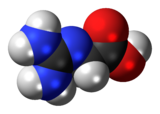Guanidinoacetate
 |
|
 |
|
 |
|
| Names | |
|---|---|
| Other names
2-Guanidinoacetic acid
|
|
| Identifiers | |
|
3D model (JSmol)
|
|
| 3DMet | B00139 |
| 1759179 | |
| ChEBI | |
| ChemSpider | |
| DrugBank | |
| ECHA InfoCard | 100.005.936 |
| EC Number | 206-529-5 |
| KEGG | |
| MeSH | glycocyamine |
|
PubChem CID
|
|
| UNII | |
|
|
|
|
| Properties | |
| C3H7N3O2 | |
| Molar mass | 117.11 g·mol−1 |
| Appearance | White crystals |
| Odor | Odourless |
| Melting point | 300 °C (572 °F; 573 K) |
| log P | −1.11 |
| Acidity (pKa) | 3.414 |
| Basicity (pKb) | 10.583 |
| Hazards | |
| GHS pictograms |  |
| GHS signal word | WARNING |
| H315, H319, H335 | |
| P261, P305+351+338 | |
| Related compounds | |
|
Related alkanoic acids
|
|
|
Related compounds
|
Dimethylacetamide |
|
Except where otherwise noted, data are given for materials in their standard state (at 25 °C [77 °F], 100 kPa).
|
|
|
|
|
| Infobox references | |
Glycocyamine (or guanidinoacetate) is a metabolite of glycine in which the amino group has been converted into a guanidine.
Glycocyamine is a direct precursor of creatine and is used as a supplement. However the metabolism of creatine from glycocyamine in the liver causes a depletion of methyl groups. This causes homocysteine levels to rise, which has been shown to produce cardiovascular and skeletal problems.
A series of studies showed that a combination of betaine and glycocyamine improves the symptoms of patients with chronic illness, including heart disease, without toxicity. Betaine can provide a methyl group to glycocyamine, via methionine, for the formation of creatine. In overall, such treatment led to less fatigue, greater strength and endurance, and an improved sense of well-being. The patients with cardiac decompensation (arteriosclerosis or rheumatic disease) and congestive heart failure had improved cardiac function. The patients gained weight (improved nitrogen balance) and saw lessened symptoms of arthritis and asthma and increased libido, and those people suffering from hypertension experienced transient reduced blood pressure. Also the studies shows the increase of glucose tolerance in both diabetic subjects and subjects without diabetes.
...
Wikipedia
